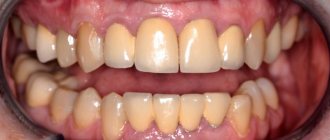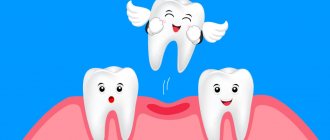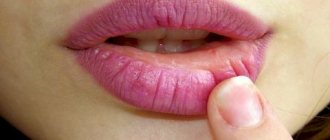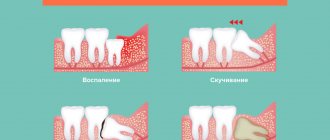How to understand that a tooth can be removed
Baby teeth begin to loosen at about 5-7 years of age.
A loose tooth can cause a lot of trouble for a child. The difficulties are mainly related to eating. With a loose tooth, it is difficult to eat solid foods, for example, raw fruits, vegetables, crackers, etc. Sooner or later, the baby tooth will fall out as it is replaced by a permanent tooth. Many people force this process, since a loose baby tooth is a source of discomfort in the oral cavity, which they want to get rid of as soon as possible. But how to pull out a tooth at home, and is it worth doing it yourself? A reasonable solution to this issue is to consult a doctor. But in practice, few people go to dentistry to remove a baby tooth. Therefore, if you decide to remove a child’s tooth yourself, then make sure it can be done.
First, examine the child's oral cavity using artificial light. Make sure there is no swelling in your mouth and your gums are a healthy pink color. Also make sure that the child does not have caries or other dental diseases, chips or cracks. If you find any, consult a doctor and give up the idea of removing them yourself.
The most important condition for removing a baby tooth is its mobility. If it wobbles slightly, then it’s too early to tear it. You can remove it when it is very loose. When you wiggle your fingers, you should be left with the impression that the tooth is being held on by one string. If the range of movements is insufficient, then persuade the child to be patient until the right moment arrives.
Is it necessary to remove wisdom teeth?
Due to the fact that wisdom teeth can be called “late” teeth, and in fact – “vestigial”, their formation and growth are associated with many circumstances, which, in turn, can negatively affect both the wisdom teeth themselves and other teeth and in general the jaw.
Thus, the incorrect position of wisdom teeth during their formation can lead to malocclusion, have a negative impact on the neighboring tooth, cause pericoronitis, inflammation of the trigeminal nerve, osteomyelitis and dental cyst.
In the case when the wisdom teeth are healthy and do not cause any discomfort (they are positioned correctly, provided with due attention during hygiene), it will be unnecessary to remove them. But when their formation and growth are associated with painful sensations, inflammatory processes, as well as deformation of the jaw dentition due to the pressure of wisdom teeth on neighboring teeth, removal is necessary.
Is it appropriate to rush to remove baby teeth?
The baby tooth falls out as it is replaced by a permanent one. When it comes out, the latter puts pressure on the base of the baby tooth, which leads to its loss. This process takes about a week. At the first stage, the ligaments that hold the tooth in the socket become thinner. In most cases, this process is painless. The range of mobility increases day by day until the tooth falls out on its own.
Dentists recommend not to rush into removing baby teeth. You should not interfere with the natural process laid down by evolution. There are four reasons why rushing to remove a baby tooth is not advisable:
- The baby tooth acts as a barrier to oral microorganisms . Thus, it protects soft tissues from bacterial infection. In addition, when removed there is a risk of microorganisms entering the bloodstream.
- Formation of the correct bite . If baby teeth are removed incorrectly, the risk of developing a malocclusion increases. When physiological processes occur in a timely manner (including the appearance of molars), the likelihood of developing a defective bite is reduced. Think about this if you are concerned about how to pull out a baby tooth at home.
- Fear of the dentist . The child will have to go to the dentist in the future. If the removal is accompanied by anxiety and fear, then in the future the child will experience anxiety before visiting the dentist.
- Overgrowth of gums. If the baby tooth has not yet fallen out, this indicates that the process needs additional time. This means that the tissues are not yet ready to replace a baby tooth with a permanent one. As soon as a baby tooth falls out, a permanent tooth immediately appears in its place. And if a baby tooth is removed too early, the gums will overgrow during this time. In this case, the permanent one will have to break through the overgrown gum.
As you can see, the rush to delete is often inappropriate. If you have any doubts about this, consult your doctor.
Simple tips
- If the tooth is very loose, offer your child an apple or carrot. While chewing, it may fall out on its own. The main thing is that the baby is not afraid of blood. Dryers or crackers are not suitable for this purpose: they are too hard and can injure the gums.
- You can pull out a tooth with a thread only if it is very loose. The thread is tied around the base, closer to the root. The tooth is pulled out with a sharp movement in the direction opposite to the jaw. Dentists do not recommend this method at home, since there is a risk of damaging the gums and leaving debris in it if you pull the tooth in a different direction, and from a psychological point of view, this is quite traumatic.
Is it possible to remove baby teeth yourself?
In most cases, children cope with this problem themselves when the tooth is sufficiently loose. In this case, there is no need to use excessive force to remove it.
It takes up to 6 days from the moment of loosening to falling out. A loose tooth brings discomfort to the child, preventing him from eating solid food. Therefore, when the tooth is already loose enough, children (or parents) remove it on their own. In other cases, “independent activity” in this matter is inappropriate.
When NOT to do this
There are a number of circumstances under which you should not pull out a child’s tooth at home. Let's look at typical cases when this procedure cannot be done at home:
- Psychological unpreparedness . Children are afraid to take such a step. This should not be treated with disdain. What seems like a trifle to adults is a tragedy to a child. These are emotions and strong experiences from which it is better to protect the child. If you notice that the child does not give in to persuasion, then you should not insist on your own. Moreover, such a procedure cannot be carried out by force.
- Acute and chronic pathologies . If the child has any acute or chronic diseases, then the procedure should be postponed or abandoned altogether. In the presence of other diseases, the removal of a baby tooth sometimes results in the development of serious complications. Only a competent doctor will be able to assess the risks and perform the procedure without complications for the child’s health.
- Hemophilia . This is a rare hereditary disease in which blood clotting is impaired. People with hemophilia are at risk of losing too much blood even from minor injuries. For this reason, a banal tearing procedure leads to large blood losses.
- Increased body temperature . The procedure is undesirable at elevated body temperatures. Even if the cause of such a symptom has not been established, the procedure should be postponed until the temperature returns to normal.
- Infectious pathologies of the oral cavity . We are talking about pathologies such as gingivitis, stomatitis and others. The danger of unauthorized removal in case of an infectious lesion of the oral cavity is the risk of introducing infection into the bloodstream.
- Inflammatory pathologies of the oral cavity . You should postpone tooth extraction if there is swelling or redness of the gums, cheeks and mucous membranes.
- Affected teeth . If the tooth that is to be removed is affected by caries, then this should only be done in a dental setting. Also, self-removal should be avoided if there are cracks or chips in the enamel.
- Painful tooth . This problem should be dealt with by a dentist. Self-removal in this case often leads to complications.
You should also refuse to remove it yourself in cases where you are not confident in your own abilities. If you have never pulled out a baby tooth before, then you should not experiment. During the removal process, something can go wrong and this will lead to undesirable consequences. In this case, it is better to entrust even a very loose baby tooth to a professional who will do this without harming the baby’s health.
Molar tooth extraction procedure
The procedure will be the same in every dentistry. With high-quality modern equipment, the procedure is quick and painless. If a patient is afraid to have a tooth removed, then he must understand the consequences that such a decision will entail. One of them is pain, which may be stronger than after surgery under anesthesia.
Removal steps
How to pull out a molar, 8 stages of work:
- Examination and diagnostic procedures.
- Anesthesia of nearby areas.
- Ligamentotomy.
- Moving the forceps under the gum.
- Dislocation.
- Extraction.
- Inspection and treatment of the resulting hole.
- Stitching.
If the impacted figure eight is removed, then an additional tissue incision will be required. In this case, the gums are sutured after the molar is removed, and complete healing will take more time.
Until the next visit to the dentist, how the molar heals after removal should be monitored by the patient himself. If any unusual pain occurs, the dentist who performed the procedure should be contacted.
Anesthesia
Local anesthesia is necessary to increase patient comfort. It is inserted before the molar tooth is removed. But not all drugs have the same effect on the human body. Painkillers are divided into groups:
- Application – suitable only for simple procedures. Not used when working with adults.
- Infiltration – suitable for simple procedures, can be used to remove mobile incisors and molars.
- Conductive – used when complex removal is necessary or for complex work. Allows you to block the peripheral branches of the nerve to cover a large area.
- Intraosseous – the anesthetic is injected directly into the bone tissue, leaving the surrounding soft tissue sensitive.
- Intraligamentary – mainly used when working with children.
When selecting an anesthetic, the doctor should always find out about the presence of an allergy to any compound in order to select the correct composition for anesthesia. Thanks to these drugs, the patient does not have to wonder whether it hurts to remove a tooth.
Is it painful to remove a tooth root?
Thanks to modern anesthesia methods, the procedure is painless. Does it hurt to have a tooth pulled out? No, and discomfort appears only after the painkiller wears off.
How to pull a tooth at home without pain
Proper preparation should be made before beginning the removal procedure. Let's look at the important preparatory steps before this procedure:
- Assess your capabilities . Proceed with the procedure only if you are confident in your abilities. If in doubt, consult a doctor. This also applies to the child. If he has a strong fear of this procedure, then it is better to take him to the doctor.
- Examine the oral cavity . Carefully examine the oral cavity for swelling, redness, as well as carious lesions and other dental diseases. If you find any, consult a doctor and do not do anything on your own.
- Check tooth mobility . Be sure to check how flexible the tooth is. If the amplitude of loosening is insignificant, then postpone the procedure until later. We remind you once again that the tooth should wobble as if it were being held on by a string.
- Prepare your tools . Later we will talk about how you can pull out a tooth at home, and what tools and things you will need for this. Prepare them in advance so that the necessary items are on hand. Prepare a small container for your child to spit into during (or after) the procedure. You should also have an antiseptic on hand.
- Have a conversation with your child . Talk to your child about this first. Tell him that the procedure is painless, so there is nothing to be afraid of. Remember that if the child twitches or acts up during the procedure, there is a high risk of incorrect tooth extraction.
- Feed the baby . After removal, it is not recommended to eat for 2-3 hours. Therefore, it is advisable to feed the child before the removal procedure.
Now let’s look at five ways to pull out a child’s loose tooth.
Method No. 1 - gradual loosening
This is the simplest and most effective way that the child himself can cope with. You don't need any improvised means for this. Gradually loosen the tooth until it falls out.
In this case, it is important to ensure that the child’s hands are clean. So before you start loosening, wash your hands with soap and water.
Method number 2 - solid food to help
Another simple way to quickly pull out a tooth at home without pain. Give your child solid food - juicy apples, dried apples or crackers. Within the first minutes, the child will feel the tooth falling out. The important thing here is not to swallow it.
Method number 3 - removal with thread
An old-fashioned method that has not lost popularity to this day. Wrap the loose tooth with floss and tie the other end to the doorknob. Then sharply pull the door, after which it will “fly out”.
If pulling a tooth with a doorknob sounds archaic to you, you can do this procedure without a door. To do this, simply pull the thread sharply. The important thing here is to pull the thread upward. If you pull to the side, you risk damaging your gums.
Method No. 4 - removal using medical gauze
Pre-moisten the gauze in an antiseptic solution. Then grab the tooth with gauze and slowly rock it. If you see that the tooth is loosening well, then it is better to pull it out in one sharp movement. In this case, removal will be painless.
Method No. 5 – tooth extraction at the dentist
The surest way not to harm your child is to see a dentist. The doctor will examine the oral cavity and take into account all the circumstances. This is the most reliable way from the point of view of the child’s health.
How to remove a tooth without pain?
In modern dental practice, tooth extraction is not carried out without high-quality, reliable and safe anesthesia for the patient’s health. In the vast majority of cases, when removing teeth, local anesthesia is used, that is, the patient remains conscious both during pain relief and during further manipulations. To remove a tooth, dentists most often resort to the injection method of local anesthesia, when an anesthetic is injected into the desired area of tissue by injection. Using the injection method, infiltration and conduction local anesthesia can be performed, while conduction anesthesia is more suitable in cases where several teeth are to be removed at once.
To remove a tooth without unnecessary trauma to the surrounding tissues and without severe stress for the patient, it is necessary to select an effective painkiller. The most common are drugs based on novocaine, lidocaine, ultracaine and some other anesthetics. The main requirements for drugs for local anesthesia are a rapid onset of effect, reliability and a high safety profile.
Before anesthesia, a special sensitivity test to the anesthetic must be performed. This is necessary primarily in order to exclude the development of such severe allergic complications as Quincke's edema and anaphylactic shock. After the dentist is convinced that the drug is safe to use, they proceed directly to pain relief. Several injections are made into the gums, and the patient may notice minor soreness and discomfort, which pass fairly quickly. After the anesthesia begins to take effect, careful tooth extraction begins.
Stopping bleeding after removal
After a baby tooth is removed, there may be some bleeding. It can be stopped by applying turunda from a bandage to the wound. This stops the bleeding within 1-3 minutes.
If the bleeding does not stop within 30 minutes or more, you should consult a doctor. Medical help should also be sought in cases where complications occur. For example, these are swelling and redness of the gums, suppuration, infection, as well as remaining fragments of teeth in the gums.
What not to do for tooth loss
When a child complains of a loose tooth, parents should not use methods to remove it, based on funny videos from the Internet:
- Do not tie one end of the string to a tooth and the other to a door handle, bicycle, or anything else. This method will not work if the tooth is firmly seated, but will only bring pain and psychological trauma to the child. There is also a high probability of removing only part of the tooth, without the root;
- tweezers, clamps, rope, pliers and other tools are also not suitable for the procedure, since carelessness can injure and frighten the child;
- moving the tooth left and right - this injures the gums, causing bleeding and causing discomfort to the child.
Have you ever helped your child loosen a tooth? Or does he do it on his own? Share interesting stories in the comments.
Main photo: 1000sovetov.ru.
How to keep teeth healthy for adults
Changing teeth occurs only once in a lifetime. Permanent teeth require special care, since once they fall out there will be no new ones. To ensure your teeth last as long as possible, doctors at the Center for Israeli Dentistry recommend adhering to the following rules:
- Visit your dentist twice a year for a checkup.
- Get timely treatment for caries and other dental diseases.
- Brush your teeth twice a day.
- Limit the consumption of sweets - the main factor in the growth of pathogenic bacteria in the oral cavity.
And remember that gum and dental diseases are easier to treat in the early stages. Therefore, at the first symptoms, immediately seek help from a doctor.
Painkillers for self-removal of teeth
| A drug | Image | Price in Russia | Price in Belarus | Price in Ukraine |
| Efferalgan | 100 | 3,2 | 41 | |
| Panadol | 100 | 3,2 | 41 | |
| Nurofen | 100 | 3,2 | 41 | |
| Moment | 200 | 7 | 82 | |
| Spazgan | 150 | 5 | 61 | |
| Baralgetas | 150 | 5 | 61 | |
| Ketorol | 200 | 7 | 82 | |
| Paracetamol | 50 | 1,6 | 21 | |
| Tempalgin | 300 | 10 | 123 | |
| Analgin | 100 | 3,2 | 41 |
- How to pull out a baby tooth at home
Attention! When treating children, you should choose only those tablets that are recommended by dentists. When the dosage of adult analgesics is reduced, there is still a chance of developing side effects and problems with the gastrointestinal tract, liver and kidneys.
Contraindications for removal
In some situations, urgent tooth extraction without pain is impossible; this procedure must be postponed to a more convenient period. Among them:
- Patient's pregnancy (1st or 3rd trimester);
- The presence of acute forms of various diseases;
- Radiation treatment;
- Diseases with local manifestations (herpes, HIV, fungus, stomatitis, syphilis);
- Mental illnesses;
- Blood diseases;
- Chemical treatment of cancer.
In such situations, it is better to choose the time to remove the tooth from the alveolus more carefully.
Indications and contraindications
There is a certain International Classification of Oral Diseases, according to which tooth extraction has code K08.1 (loss of a unit due to injury, accident, complex periodontitis or forced removal). In addition, when bleeding begins from an exposed tooth socket, code K58 can be additionally assigned, which is called “Bleeding.”
The most common indications for surgery to remove a molar include: severe fracture of the coronal part, partial or complete retention, curvature of roots, incorrect direction of growth, increased crowding, upcoming installation of braces, bridges or wearing aligners, neoplasms, etc. .
The procedure also has some contraindications. For example, tooth extraction will need to be postponed in case of a serious inflammatory process in the oral cavity, in the presence of chronic diseases, especially aggravated at the moment, in case of severe psychological disorders, as well as during the first and third trimester of pregnancy in women.











